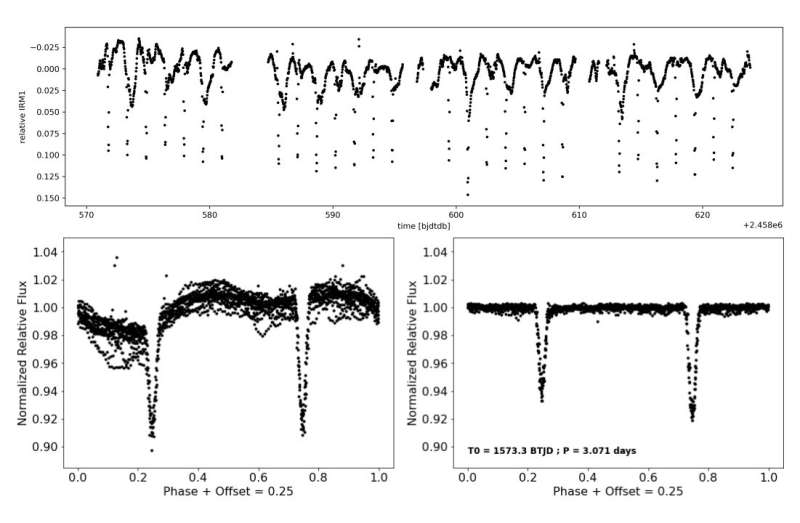November 21, 2022 report
New eclipsing binary discovered with TESS

Using NASA's Transiting Exoplanet Survey Satellite (TESS), astronomers have detected a new low-mass, pre-main-sequence binary system. The newfound binary, designated 2M1222−57, contains two stars the size of the sun but less massive than it. The finding is reported in a paper published November 15 on the arXiv pre-print repository.
Eclipsing binaries (EBs) are systems showing regular light variations due to one of the stars passing directly in front of its companion. In EBs, the orbit plane of the two stars lies so nearly in the line of sight of the observer that the components undergo mutual eclipses. Such systems can provide direct measurement of the mass, radius and effective temperature of stars.
Now, a team of astronomers led by Keivan G. Stassun of Vanderbilt University in Nashville, Tennessee, has found a new EB located some 345 light years away, in the Lower-Centaurus Crux (LCC) subgroup of the Scorpius Centaurus OB Association.
"From TESS light curve observations, we have identified 2M1222−57 as a low-mass, pre–main-sequence (PMS) eclipsing binary (EB) with a 3.07-day orbital period," the researchers wrote in the paper.
According to the study, the primary and secondary stars of 2M1222−57 have radii of about 0.976 and 0.942 solar radii, while their masses are 0.735 and 0.668 solar masses, respectively. With an effective temperature of 3,749 K, the primary star is around 100 K hotter than its companion. The system is estimated to be 16.2 million years old.
By analyzing the results, the astronomers concluded that the radii of both stars of 2M1222−57 are inflated, and the temperatures suppressed. Moreover, they found that the lithium abundances of these two stars are 2.0 dex less depleted than predicted by the standard models.
The observations also provided evidence for a circumbinary disk around 2M1222−57. In general, the spectral energy distribution (SED) shows clear excess at about 10 µm indicative of such a disk.
Furthermore, speckle-imaging observations of 2M1222−57 suggest that there may be a tertiary companion in the system, some 100 AU away from the two stars. The researchers estimate that the mass of this object should be at a level of around 2.0 solar masses, placing the object close to but likely above the substellar mass boundary.
Summing up the results, the authors of the paper underlined how their findings could help advance our knowledge about the population of young stars, noting that stellar magnetic fields have significant and measurable effects on the fundamental properties of these objects.
"To a remarkable degree, the 2M1222−57 system presents very strong evidence that magnetic activity in young stars alters both their global properties and the physics of their interiors," the astronomers wrote.
More information: Keivan G. Stassun et al, A Low-Mass Pre-Main-Sequence Eclipsing Binary in Lower Centaurus Crux Discovered with TESS, arXiv (2022). DOI: 10.48550/arxiv.2211.07899
Journal information: arXiv
© 2022 Science X Network



















